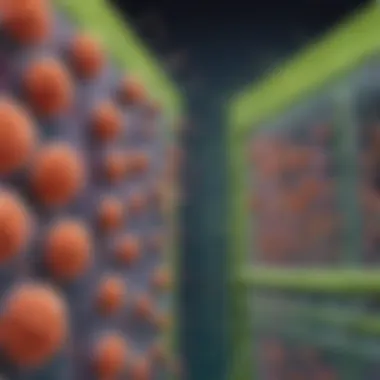Unlocking the Mechanisms of Bacterial Eradication by Disinfectants


Science Fun Facts
Did you know that disinfectants play a crucial role in eradicating harmful bacteria from surfaces, helping to maintain hygiene and prevent infections? These powerful agents employ intricate mechanisms to target and neutralize bacteria effectively.
Let's delve into the fascinating world of disinfectants and uncover how they work tirelessly to keep us safe from harmful pathogens. It's truly amazing to witness the impact of these substances in our daily lives, ensuring our environments remain clean and free from harmful bacteria.
Understand Disinfectants and Their Role
Disinfectants are chemical agents designed to eliminate bacteria, viruses, and other harmful microorganisms from surfaces. By disrupting the cell structures of these pathogens, disinfectants effectively neutralize them, preventing their growth and proliferation.
Key Mechanisms of Disinfection
One of the primary mechanisms through which disinfectants kill bacteria is by disrupting the cell membrane integrity. This essential barrier protects bacteria from external threats, and when compromised by disinfectants, it leads to the leakage of vital cell components, ultimately causing cell death.
Moreover, disinfectants can also denature proteins within bacterial cells, disrupting their essential functions and metabolic processes. This interference with bacterial proteins halts their growth and replication, further aiding in the elimination of harmful bacteria.
Types of Disinfectants
There are various types of disinfectants available, each with unique properties and mechanisms of action. Common disinfectants include alcohols, chlorine-based compounds, quaternary ammonium compounds, and hydrogen peroxide.
Alcohols are effective against a wide range of bacteria and viruses and are commonly used as hand sanitizers. Chlorine-based compounds, such as bleach, are powerful oxidizing agents that can effectively kill bacteria and disinfect surfaces.
Quaternary ammonium compounds are widely used in disinfecting surfaces in healthcare settings due to their broad-spectrum antimicrobial activity. Hydrogen peroxide, on the other hand, is a strong oxidizing agent that can eliminate bacteria through oxidative damage.
Importance of Disinfection
Final Thoughts
Introduction
The utilization of disinfectants in eradicating harmful bacteria is a critical aspect of maintaining cleanliness and hygiene. Understanding the mechanisms through which disinfectants operate to eliminate bacteria is essential for upholding public health standards. By delving into the diverse methods employed by disinfectants to target and neutralize bacteria, we unravel the intricate web of disinfection's significance. This section will provide a detailed exploration of the mechanisms through which disinfectants combat bacteria, shedding light on their pivotal role in preventing infections.
Importance of Disinfectants
Maintaining Clean and Hygienic Environments


In the realm of maintaining clean and hygienic environments, disinfectants play a vital role in combatting harmful pathogens. The key characteristic of disinfectants lies in their ability to effectively eliminate bacteria, ensuring surfaces are free from microbial contaminants. This quality makes them a popular choice for maintaining hygiene standards in various settings, from medical facilities to household environments. Despite their efficacy, some disinfectants may contain harsh chemicals, posing potential disadvantages in certain applications.
Preventing the Spread of Infections
An essential aspect of disinfectants is their contribution to preventing the spread of infections. By targeting and neutralizing bacteria on surfaces, disinfectants act as a barrier against the transmission of harmful pathogens. Their key characteristic lies in disrupting the microbial chain of infection, thereby reducing the risk of illnesses spreading among individuals. While disinfectants offer significant advantages in inhibiting the spread of infections, overreliance on them may lead to the development of resistant strains of bacteria.
Ensuring Public Health and Safety
Disinfectants play a crucial role in ensuring public health and safety by eliminating disease-causing bacteria from various surfaces. Their key characteristic of effectively eradicating harmful pathogens contributes to creating a safer environment for all individuals. The unique feature of disinfectants lies in their ability to disinfect a wide range of surfaces, from skin to inanimate objects. Despite their advantages in promoting public health, improper use of disinfectants can result in potential health risks and environmental hazards.
Types of Disinfectants
Chemical Disinfectants
Chemical disinfectants are instrumental in combatting bacteria through their potent antimicrobial properties. The key characteristic of chemical disinfectants is their ability to kill a broad spectrum of pathogens, making them a versatile choice for disinfection purposes. Their unique feature lies in the variety of formulations available, each tailored to different types of bacteria. While chemical disinfectants offer rapid and effective disinfection, their overuse can lead to exposure risks and environmental pollution.
Natural Disinfectants
Natural disinfectants harness the power of natural compounds to eliminate bacteria while minimizing harmful impacts on the environment. The key characteristic of natural disinfectants is their eco-friendly nature, making them a sustainable choice for disinfection. Their unique feature lies in being derived from plant-based sources, offering a non-toxic alternative to chemical disinfectants. Despite their advantages in promoting environmental health, natural disinfectants may have limitations in terms of efficacy against certain virulent strains of bacteria.
Antibacterial Agents
Antibacterial agents are specialized disinfectants designed to target and disrupt the growth of bacteria. The key characteristic of antibacterial agents is their ability to inhibit bacterial proliferation, reducing the risk of infections. Their unique feature lies in specifically targeting bacterial cells, minimizing the chances of bacterial resistance. While antibacterial agents offer targeted protection against bacteria, prolonged use may lead to the development of resistant bacterial strains and potential health implications.
Mechanisms of Action
When delving into the intricate world of understanding how disinfectants effectively eliminate bacteria on surfaces, it becomes imperative to grasp the mechanisms of action governing this process. The mechanisms of action serve as the blueprint dictating how disinfectants interact with harmful bacteria, ultimately leading to their demise. By comprehending these mechanisms, one can appreciate the complexity and precision involved in the battle against harmful pathogens. Understanding the mechanisms of action provides crucial insights into the efficacy and thoroughness of disinfection procedures, shedding light on the essential role they play in maintaining cleanliness and curbing the spread of infections.
Cell Membrane Disruption
Interaction with Lipid Bilayers
In the realm of disinfection, interaction with lipid bilayers emerges as a pivotal aspect when considering how disinfectants combat bacteria. The interaction with lipid bilayers involves the strategic targeting of bacterial cell membranes, where the disinfectant disrupts the integrity of these protective layers. This disruption leads to destabilization and permeabilization of the membrane, effectively compromising the structural foundation of the bacterial cell. The advantage of this approach lies in its targeted nature, focusing on a vital component of bacterial survival for maximum impact. However, challenges may arise concerning the specificity of certain disinfectants towards lipid bilayers, necessitating careful consideration of product selection for optimal outcomes.
Permeability Changes


Another critical facet within the domain of cell membrane disruption is permeability changes induced by disinfectants. By altering the permeability of bacterial cell membranes, disinfectants impede crucial functions necessary for bacterial survival. This alteration in permeability hampers the ability of bacteria to maintain internal stability and regulation, contributing to their eventual demise. The exceptional characteristic of permeability changes lies in their broad-spectrum effectiveness, targeting fundamental processes essential for bacterial viability. Nonetheless, variations in the efficacy of disinfectants in inducing permeability changes may pose a challenge, necessitating a nuanced approach to product selection based on specific disinfection requirements.
Protein Denaturation
Effect on Enzymes
When exploring the realm of protein denaturation, the effect on enzymes stands out as a key player in the battle against bacteria. Disinfectants exert their influence by disrupting the structure and function of enzymes vital for bacterial metabolic processes. This disruption leads to the inactivation of enzymes critical for bacterial survival, impairing their ability to carry out essential functions. The standout characteristic of this mechanism lies in its targeted approach towards neutralizing key components of bacterial metabolism, ensuring a comprehensive impact on bacterial viability. However, challenges may arise concerning the potential non-specific effects of certain disinfectants on enzymes, necessitating careful evaluation of product compatibility to optimize disinfection outcomes.
Structural Alterations
Within the realm of protein denaturation, structural alterations play a significant role in dismantling bacterial defenses. By inducing structural changes in key proteins within bacterial cells, disinfectants disrupt essential molecular machinery, impeding vital cellular processes. These alterations lead to a cascade of dysfunction within bacterial cells, ultimately culminating in their incapacity to survive. The distinguishing feature of structural alterations lies in their disruptive nature, targeting key structural elements to derail bacterial function effectively. However, variations in the susceptibility of different bacteria strains to structural alterations may pose a challenge, underscoring the importance of tailored disinfection strategies based on specific microbial contexts.
Factors Influencing Efficacy
In the realm of disinfectants and their role in combating harmful bacteria, understanding the factors that influence their efficacy stands paramount. The effectiveness of a disinfectant hinges on various elements such as concentration, contact time, and the presence of organic matter. These factors intricately dictate the disinfectant's ability to eliminate bacteria from surfaces and uphold cleanliness. Proper consideration of these factors not only ensures thorough disinfection but also aids in preventing the spread of infections, thereby safeguarding public health and well-being. Delving into the specifics of each factor provides invaluable insights into optimizing disinfection practices.
Concentration of Disinfectant
Impact on Microbial Activity:
Exploring the impact of concentration on microbial activity unveils the pivotal role this aspect plays in the overall effectiveness of a disinfectant. The concentration of a disinfectant directly influences its potency in killing bacteria, with higher concentrations typically yielding greater microbial eradication. This characteristic not only enhances the disinfectant's efficacy but also minimizes the risk of bacterial resistance, a crucial consideration in the realm of infection prevention. The unique feature of concentration lies in its ability to deliver swift and thorough disinfection, making it a preferred choice for environments where stringent hygiene standards are non-negotiable.
Residual Effects:
Diving into the realm of residual effects sheds light on the enduring impacts of disinfectants beyond their initial application. Residual effects refer to the lingering antimicrobial activity possessed by certain disinfectants even after they have dried on a surface. This characteristic offers prolonged protection against bacteria, reducing the chances of recontamination between regular cleaning intervals. While advantageous in maintaining long-lasting cleanliness, residual effects may also pose challenges in terms of potential chemical exposure if not handled with care. Understanding the nuances of residual effects enables informed decision-making regarding disinfectant selection and application, ensuring optimal efficacy in combating bacteria.
Contact Time
Duration of Exposure:
When considering the importance of contact time in disinfection practices, the duration of exposure to a disinfectant emerges as a critical factor influencing its effectiveness. Longer contact times allow the disinfectant to interact comprehensively with bacteria, ensuring thorough eradication. This extended exposure period is particularly beneficial in scenarios where deep cleaning and disinfection are necessary, emphasizing the importance of patience and adherence to recommended contact times. Leveraging the unique feature of extended duration of exposure optimizes the disinfectant's performance, making it a reliable choice for environments requiring rigorous bacterial elimination.
Penetration and Effectiveness:
Unpacking the concept of penetration and effectiveness sheds light on the disinfectant's ability to permeate surfaces and combat bacteria effectively. The penetrating power of a disinfectant determines its reach into intricate surface crevices where bacteria may reside, maximizing the scope of disinfection. An effective disinfectant not only penetrates deeply but also targets bacteria adeptly, ensuring comprehensive eradication. This dual capability underscores the significance of selecting disinfectants with high penetration and effectiveness, especially in environments prone to bacterial contamination.


Organic Matter
Interference with Disinfection:
Considering the influence of organic matter on disinfection underscores the potential challenges posed by its presence. Organic matter, such as dirt or debris, can impede the disinfectant's efficacy by creating a physical barrier between the disinfectant and bacteria. This interference may compromise the disinfection process, leading to incomplete microbial eradication and reduced hygiene standards. Recognizing the significance of addressing organic matter underscores the importance of pre-cleaning surfaces to remove potential barriers to effective disinfection. An understanding of how organic matter interferes with disinfection enables proactive measures to enhance the overall efficacy of disinfection protocols.
Need for Pre-cleaning:
Exploring the necessity of pre-cleaning in disinfection protocols reveals the foundational role this step plays in optimizing disinfectant performance. Pre-cleaning involves the removal of visible dirt and debris from surfaces before applying a disinfectant, ensuring unobstructed contact between the disinfectant and bacteria. This preparatory step sets the stage for effective disinfection by eliminating physical obstacles that may hinder the disinfectant's actions. While requiring additional time and effort, pre-cleaning proves indispensable in enhancing the efficacy of disinfectants, emphasizing the significance of thorough surface preparation in maintaining optimal hygiene levels.
Application and Best Practices
Surface Disinfection
Proper Techniques
Exploring the realm of proper techniques within surface disinfection unveils a spectrum of precise methods contributing to the overall goal of eliminating bacteria effectively. The emphasis on thorough cleaning procedures, appropriate disinfectant selection, and uniform application techniques distinguishes proper techniques as a favorable choice for ensuring optimal disinfection outcomes. The unique feature of proper techniques lies in their ability to minimize microbial activity and reduce the potential for bacterial regrowth. Practitioners can benefit significantly from incorporating proper techniques into their disinfection protocols, although challenges such as time constraints and resource allocation may present as disadvantages within this context.
Efficacy on Different Surfaces
Delving into the efficacy of disinfectants on different surfaces sheds light on the critical role played by surface composition in determining disinfection effectiveness. Understanding the unique characteristics of various surfaces aids in tailoring disinfection methods to specific needs, optimizing the eradication of bacteria across diverse environments. The adaptability of disinfectants to different surfaces marks their effectiveness in ensuring comprehensive microbial elimination. However, challenges such as varying surface textures and compatibility issues may pose limitations to their efficacy across different surfaces.
Hand Hygiene
Role in Preventing Infections
Analyzing the significance of hand hygiene in preventing infections underscores the pivotal role played by this practice in reducing the transmission of harmful bacteria. The meticulous adherence to proper hand hygiene protocols significantly minimizes the risk of contamination and infection spread, particularly in high-traffic settings. The unique feature of hand hygiene lies in its direct impact on infection prevention by targeting one of the primary sources of microbial transfer. While the advantages of robust hand hygiene practices are evident, challenges such as compliance issues and accessibility to hygiene facilities may pose as potential disadvantages within this domain.
Choosing the Right Products
Exploring the process of selecting appropriate products for hand hygiene underscores the importance of aligning product characteristics with specific hygiene needs. The emphasis on choosing products with antibacterial properties, skin-friendly ingredients, and sustainable packaging distinguishes the right products as essential components of effective hand hygiene routines. The unique feature of choosing the right products lies in their ability to enhance disinfection efficiency while promoting skin health and environmental sustainability. Despite the benefits associated with selecting the right products, challenges such as product availability and affordability may present as limitations in maintaining consistent hand hygiene practices.
Environmental Disinfection
Impact on Public Health
Addressing the impact of environmental disinfection on public health offers insights into the broader implications of maintaining hygienic surroundings. The meticulous decontamination of public spaces significantly reduces the risk of infection transmission, safeguarding the health and safety of individuals within communal settings. The unique feature of environmental disinfection lies in its collective benefit to society by minimizing disease outbreaks and promoting overall well-being. While the advantages of environmental disinfection are substantial, challenges such as logistical constraints and resource-intensive procedures may hinder the widespread implementation of thorough decontamination practices.
Decontamination Procedures
Exploring the realm of decontamination procedures illuminates the systematic approaches employed to neutralize harmful pathogens and ensure hygienic environments. The meticulous execution of decontamination protocols, including targeted disinfection methods and proper waste disposal, serves as a cornerstone in preventing infection spread and maintaining cleanliness. The unique feature of decontamination procedures lies in their ability to address specific microbial threats effectively while minimizing the potential for cross-contamination. Despite the advantages associated with standardized decontamination procedures, challenges such as regulatory compliance and resource allocation may pose limitations to their widespread adoption in diverse environmental settings.







